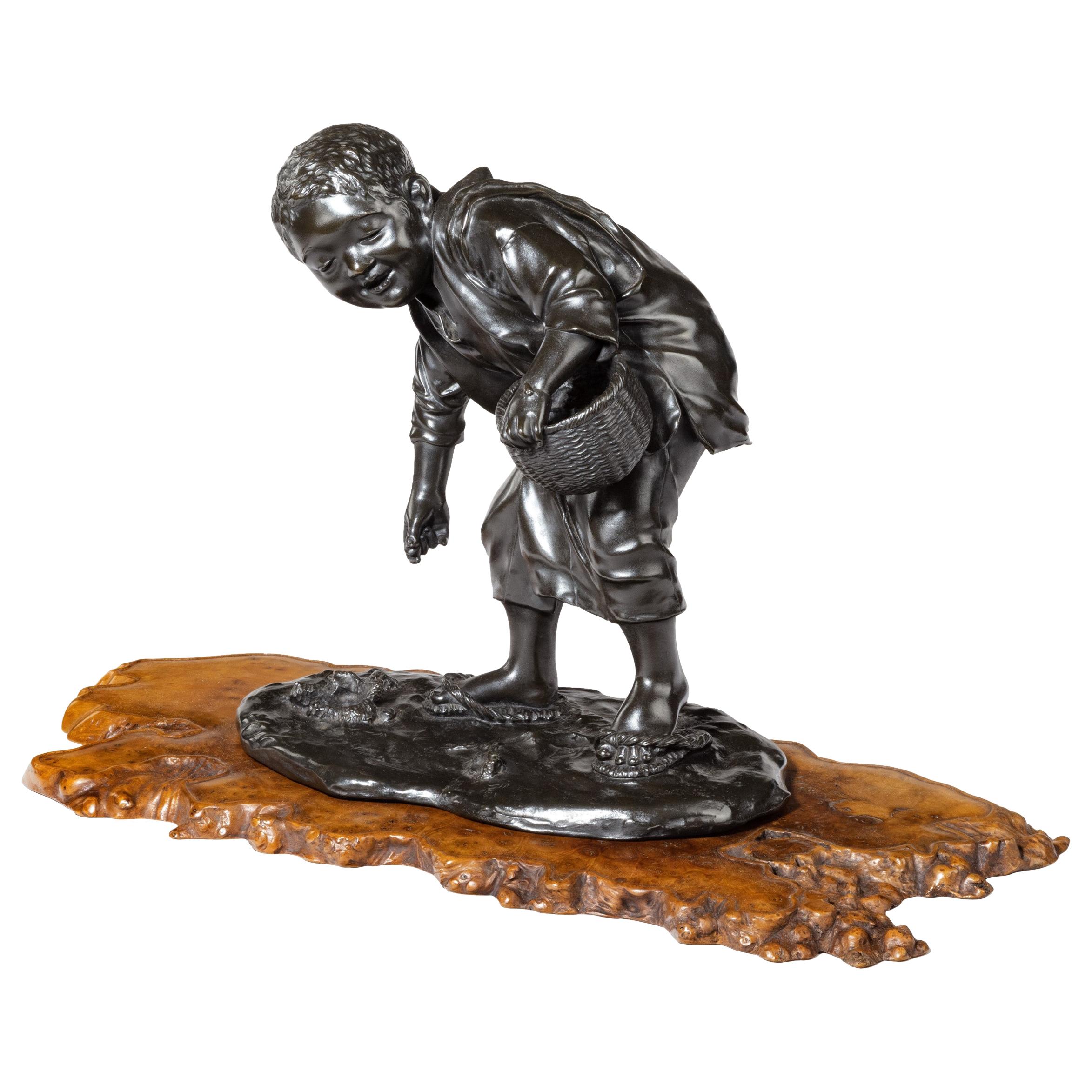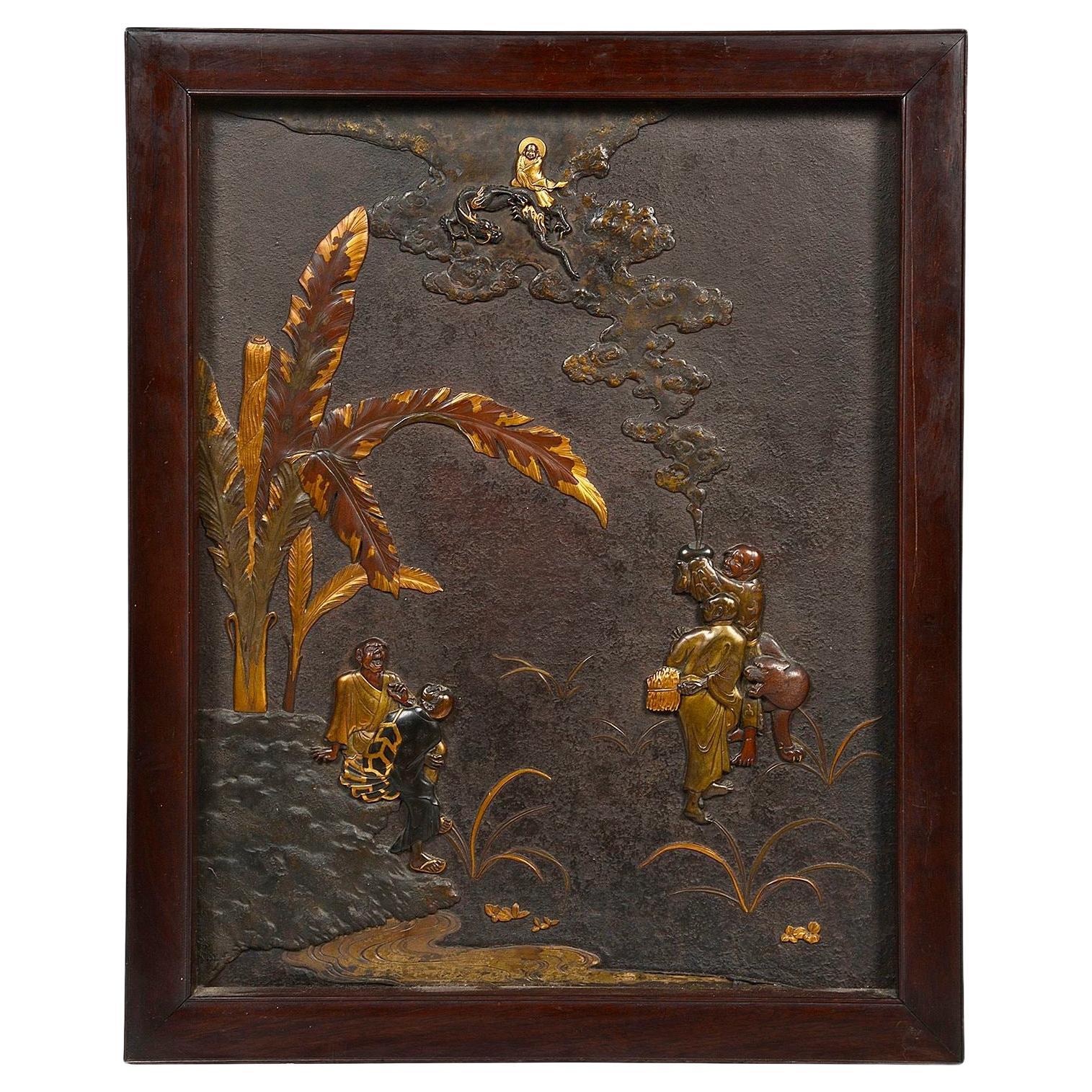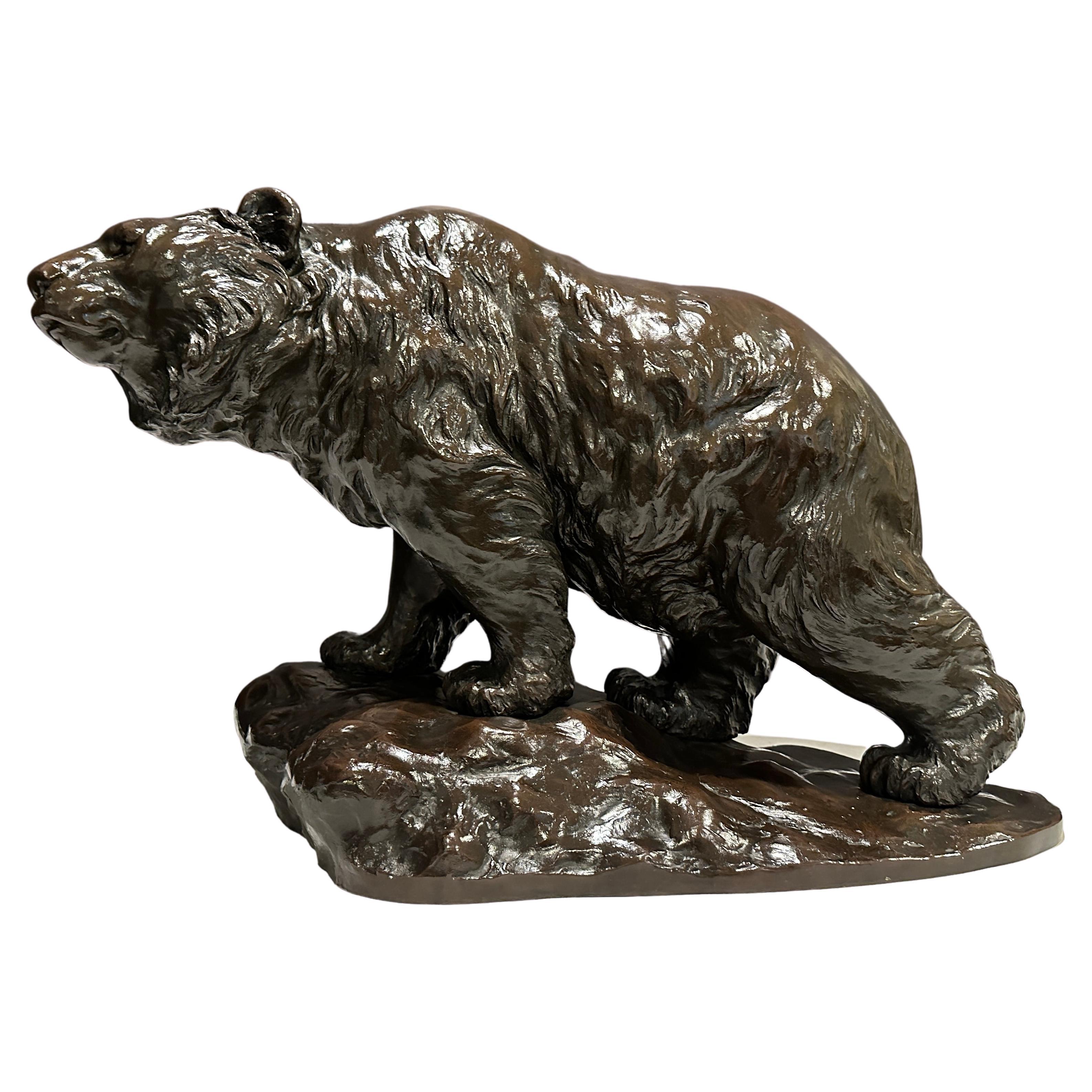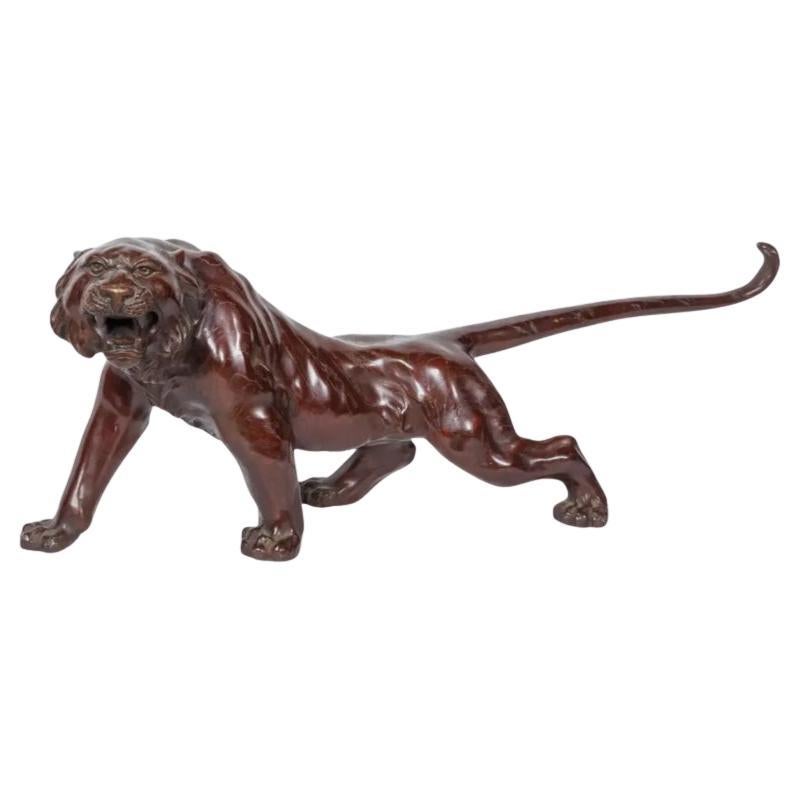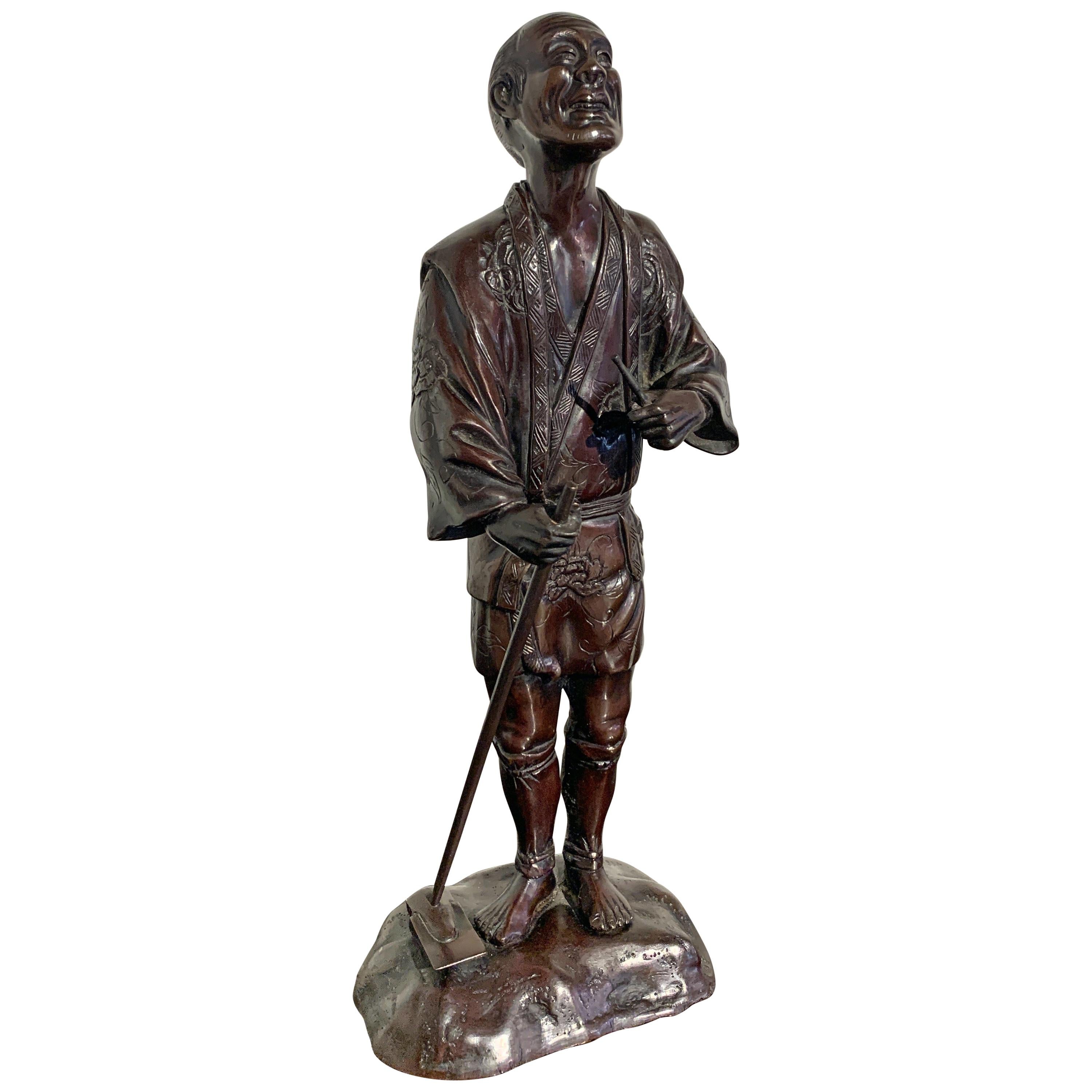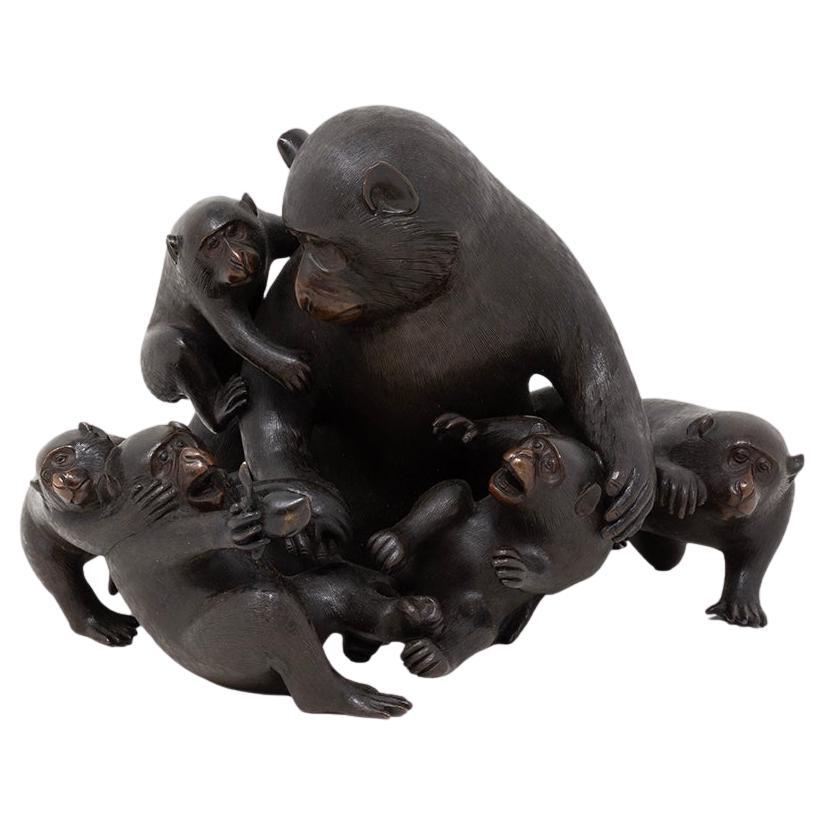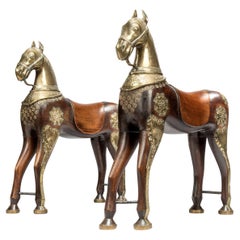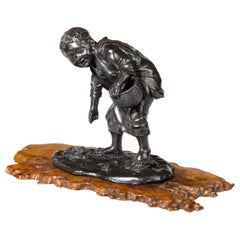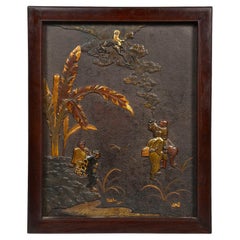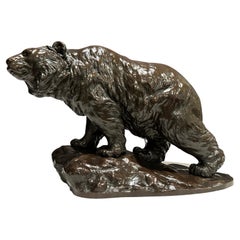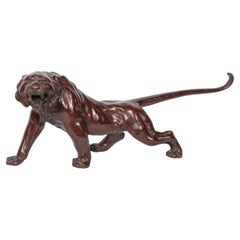Items Similar to A Bronze Meiji Period Elephant Jardiniere
Want more images or videos?
Request additional images or videos from the seller
1 of 5
A Bronze Meiji Period Elephant Jardiniere
About the Item
The richly patinated bronze surface is beautifully chased, clearly stamped to the underside of the base by the highly regarded foundry of Genryusai Seiya, a specialist in bronze objects primarily okimonos of all varying scales usually depicting exotic animals. This large-scale plant holder is decorated throughout its circumference with a parade of elephants of varying sizes and poses, some of the elephants appear to be frolicking in water, whilst the legs of the smaller elephants serve as the sturdy base for this very useful and decorative vessel, fully artist signed to the underside Japan, circa 1890-1900
- Creator:Genryusai Seiya (Workshop/Studio)
- Dimensions:Height: 9.45 in (24 cm)Width: 15.36 in (39 cm)Depth: 15.36 in (39 cm)
- Style:Meiji (Of the Period)
- Materials and Techniques:Bronze,Cast
- Place of Origin:
- Period:
- Date of Manufacture:1890
- Condition:Wear consistent with age and use.
- Seller Location:London, GB
- Reference Number:1stDibs: LU10128242280392
About the Seller
New to 1stDibs
Joined in the past six months.
No Reviews Yet
Vetted Professional Seller
Every seller passes strict standards for authenticity and reliability
1stDibs seller since 2024
- ShippingRetrieving quote...Shipping from: London, United Kingdom
- Return Policy
Authenticity Guarantee
In the unlikely event there’s an issue with an item’s authenticity, contact us within 1 year for a full refund. DetailsMoney-Back Guarantee
If your item is not as described, is damaged in transit, or does not arrive, contact us within 7 days for a full refund. Details24-Hour Cancellation
You have a 24-hour grace period in which to reconsider your purchase, with no questions asked.Vetted Professional Sellers
Our world-class sellers must adhere to strict standards for service and quality, maintaining the integrity of our listings.Price-Match Guarantee
If you find that a seller listed the same item for a lower price elsewhere, we’ll match it.Trusted Global Delivery
Our best-in-class carrier network provides specialized shipping options worldwide, including custom delivery.More From This Seller
View AllA pair of brass mounted Teak processional horses
Located in London, GB
A PAIR OF BRASS-MOUNTED TEAK PROCESSIONAL HORSES
LATE 19TH CENTURY, PROBABLY SOUTH INDIA
The elongated bodies beautifully carved with engraved and punch-brass decorated mounts.
In traditional Indian weddings the groom often rides a white horse, also known as a Ghodi. Some believe that riding a mare signifies the groom is ready to take on responsibilities
Provenance
Anonymous collection sale, 'London Living: Wilton Crescent, Belgravia & Avenue Road...
Category
Antique Late 19th Century Indian Sculptures and Carvings
Materials
Wood
You May Also Like
19th Century Meiji Period Bronze of a Boy Collecting Sweet Chestnuts by Seiya
Located in Lymington, Hampshire
A charming Meiji period bronze of a boy collecting sweet chestnuts by Seiya, he carries a basket and is looking down at an insect crawling over his hand, he is also evidently wearing...
Category
Antique 1880s Japanese Meiji Figurative Sculptures
Materials
Bronze
Meiji period bronze plaque.
Located in Brighton, Sussex
A fine quality late 19th Century (Meiji period 1868-1912) patinated and gilded bronze plaque depicting four men looking into the sky, two under a Palm tree, the other two standing next to a Tiger and holding a smoking vessel...
Category
Antique Late 19th Century Japanese Sculptures and Carvings
Materials
Bronze
$23,731
Large And Impressive Meiji Period Bronze Bear, Signed
Located in Norwood, NJ
Large and impressive patinated bronze sculpture of a bear. As part of our Japanese works of art collection we are delighted to offer this magnificent high quality Meiji period Okimon...
Category
Antique Early 1900s Japanese Meiji Sculptures and Carvings
Materials
Bronze
A Massive Japanese Patinated Bronze Sculpture of a Tiger, Meiji Period
Located in New York, NY
A Massive Japanese Patinated Bronze Sculpture of a Tiger, Meiji Period. Signed.
Measuring an impressive 44 inches in length, this extraordinary sculpture is a striking example of t...
Category
Antique 19th Century Japanese Meiji Sculptures and Carvings
Materials
Bronze
Japanese Tokyo School Bronze Okimono of a Farmer, Meiji Period
Located in Austin, TX
A very fine and detailed Tokyo School cast bronze okimono (decorative sculpture) of a smiling farmer, Meiji period, late 19th century, Japan.
The e...
Category
Antique Late 19th Century Japanese Meiji Sculptures and Carvings
Materials
Bronze
Japanese Meiji Period Bronze Monkey Group Sculpture Okimono Shosai
Located in Newark, England
Featuring Seven Japanese Macaques
Form our Japanese collection, we are delighted to offer this Japanese Bronze Monkey Group by Shosai. The Japanese Bronze Group displaying a male father monkey and his infants playing around and being mischievous with Persimmon fruit. The monkeys modelled as Japanese macaque monkeys (snow monkey). The bronze okimono is beautifully patinated with a highly lifelike and naturalistic casting signed to the underside Shosai 正齊鋳. The Bronze group dates to the Meiji Period (1868-1912) circa 1885.
Japanese macaque (snow monkey) is a terrestrial Old World monkey species that is native to Japan. They are known as snow monkeys because some live in areas where snow covers the ground for long periods each year hence their nickname. No other non-human primate lives further north or in a colder climate than the snow monkey. Individuals have brownish grey fur, pinkish-red faces, and short tails. Two subspecies are known and their conservation Status is of least concern. In Japan, the species is known as Nihonzaru ニホンザル, 日本 (Japan/Nihon) and saru 猿 (monkey) to distinguish it from other primates, but the Japanese macaque is the only species of monkey in Japan.
The Japanese macaque features heavily in the religion, folklore, and art of Japan, as well as in proverbs and idiomatic expressions in the Japanese language. They are often seen in paintings, block prints and represented in all manner of carvings from Okimono to netsuke. Many of these art forms reside in the world’s most famous museums and collections, some of the most prominent pieces by artists such as Mori Sosen and Kawanabe Kyosai. In Shinto belief (Japan’s indigenous religion/nature religion) legendary mythical beasts known as raiju sometimes appeared as monkeys and kept Raijin (the god of lightning/storms) company. In another well known tale the three wise monkeys who warn people to “see no evil, hear no evil and speak no evil” can be seen depicted in relief over the door of the famous Tosho-gu shrine in Nikko.
Meiji Period was an era of Japanese history that spanned from 1868 to 1912. It was the first half of the Empire of Japan, when the Japanese people began to build a paradigm of a modern, industrialised nation state and emergent great power, influenced by Western countries and aesthetics. As a result of radically different ideas, the changes to Japan were profound and it affected the social structure, politics, economy, military, and foreign relations across the board. The period corresponded to the reign of Emperor Meiji and was preceded by the Keio era and was succeeded by the Taisho era.
Cultural Art during the Meiji Period was of particular interest to the government and they overhauled the art export market which in turn promoted Japanese arts via various world’s fairs, beginning in Vienna at the world fair in 1873. The government heavily funded the fairs and took an active role organising how Japan’s culture was presented to the world including creating a semi-public company named Kiritsu Kosho Kaisha (First Industrial Manufacturing Company). The Kiritsu Kosho Kaisha was used to promote and commercialise exports of Japanese art and established the Hakurankai Jimukyoku (Exhibition Bureau) to maintain quality standards. For the 1876 Centennial International Exhibition in Philadelphia, the Japanese government created a Centennial Office and sent a special envoy to secure space for the 30,000 items that would be displayed. The Imperial Household also took an active interest in arts and crafts, commissioning works by select artists to be given as gifts for foreign dignitaries further emphasising the high quality and importance of Japanese art. Just before the end of the 19th century in 1890, the Teishitsu Gigeiin (Artist to the Imperial Household) system was created to recognise distinguished artists. These artists were selected for their exceptionally high quality wares and talent in their own industry. Over a period of 54 years Seventy artists were appointed, amongst these were ceramicist Makuzu Kozan and cloisonné enamel artist...
Category
Antique Late 19th Century Japanese Meiji Sculptures and Carvings
Materials
Bronze
Recently Viewed
View AllMore Ways To Browse
Antique Bronze Furniture Legs
Antique Elephant
Antique Elephants
Furniture With Animal Carving
Small Elephant
Elephant Base
Japanese Elephant
Antique Bronze Elephant
Elephant Leg
Large Gold Elephant
Japanese Bronze Animals
Meiji Bronze Sculptures
Antique Plant Holder
Antique Plant Holders
Elephant Jardiniere
Japanese Meiji Jardiniere
Bronze Elephant Signed
Meiji Bronze Animal
